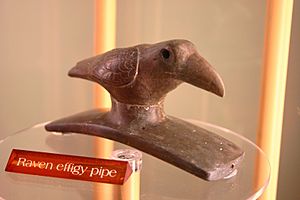Marksville culture facts for kids
The Marksville culture was an ancient group of people who lived in parts of what is now Louisiana, Mississippi, and Arkansas. They also spread eastward along the Gulf Coast near Mobile Bay. These people lived from about 100 BCE to 400 CE.
Their name comes from the Marksville Prehistoric Indian Site in Avoyelles Parish, Louisiana. The Marksville culture existed at the same time as the Hopewell cultures found in Ohio and Illinois. The Marksville people grew from an earlier group called the Tchefuncte culture. Later, they developed into the Baytown and Troyville cultures. Even later, they became the Coles Creek and Plum Bayou cultures. Many historians believe they are the ancestors of the historic Natchez and Taensa peoples.
What Was the Marksville Culture Like?
The Hopewell tradition was a large network of related groups. They were connected by a trading system called the Hopewell Exchange System. The Marksville culture was the southern part of this big network.
Marksville settlements were often large. They were usually built on high ground near major rivers. When archaeologists dug up burial mounds from this time, they found interesting things. These mounds were built for important people in the community.
Inside the mounds, they found special items. These items were made from rare materials brought from far away. Some examples include copper pipes, ear decorations, bracelets, and beads. They also found rare minerals, stone pipes, mica figures, seashells, and greenstone tools. The pipes were flat with a hole for a stem and a bowl in the middle. Sometimes, animal figures were carved on the pipes, with the bowl on the animal's back.
Important leaders in the Marksville culture organized daily life. They also led special burial ceremonies. These ceremonies were a very important part of their culture. The mounds were built slowly, over many years. First, a flat, low platform was made. The ceremonies might have happened years apart. People who died between ceremonies were kept in other places. Later, their remains were gathered and buried together in the mounds.
The Marksville people found and grew their food in the same ways as the earlier Archaic and Tchefuncte periods.
Amazing Marksville Pottery
Marksville pottery was made from local clay. However, its designs and decorations looked very similar to pottery found in Illinois and Ohio. This suggests that the Marksville people traded and connected with groups far away.
A typical pot was about three to five inches tall and three to seven inches wide. It was often decorated with geometric shapes and animal designs, especially stylized birds. The pottery was well-made and often had shallow carved lines. This decorated pottery was mainly used for special ceremonies. For daily use, they had simpler, plain pots.
Marksville pottery also influenced the Santa Rosa pottery. This pottery was a key feature of the Santa Rosa-Swift Creek culture. This group lived to the east of the Marksville area, along the Gulf Coast.
Besides pottery, the Marksville culture also made jewelry and other items. These were often created as part of the burial ceremonies.
When Did the Marksville Culture Live?
The Marksville culture came after the Tchefuncte culture. Over time, the Marksville culture changed into other groups. In southeastern Louisiana and western Mississippi, it became the Troyville culture. In northeastern Louisiana, northwestern Mississippi, and southeastern Arkansas, it developed into the Baytown culture.



